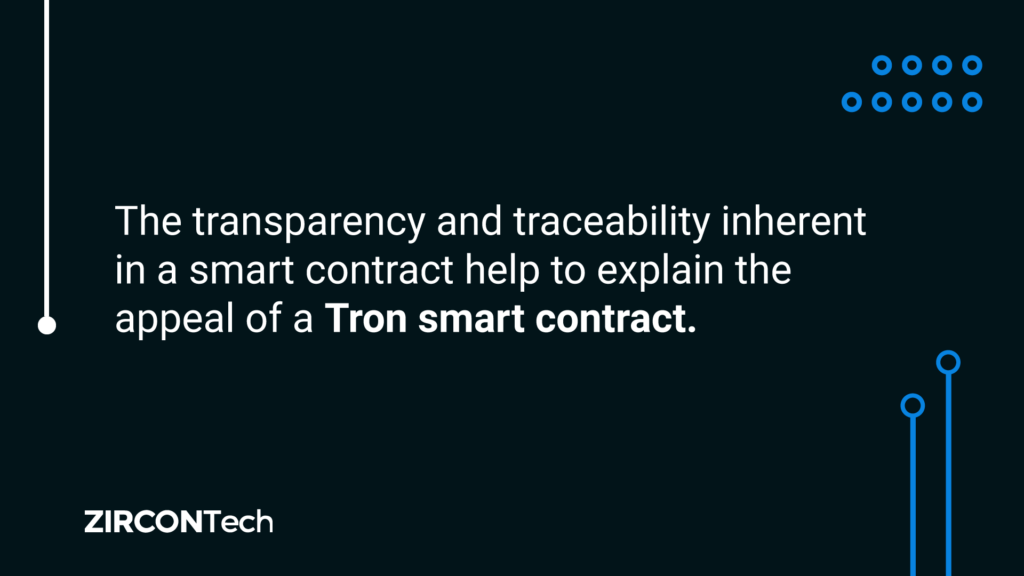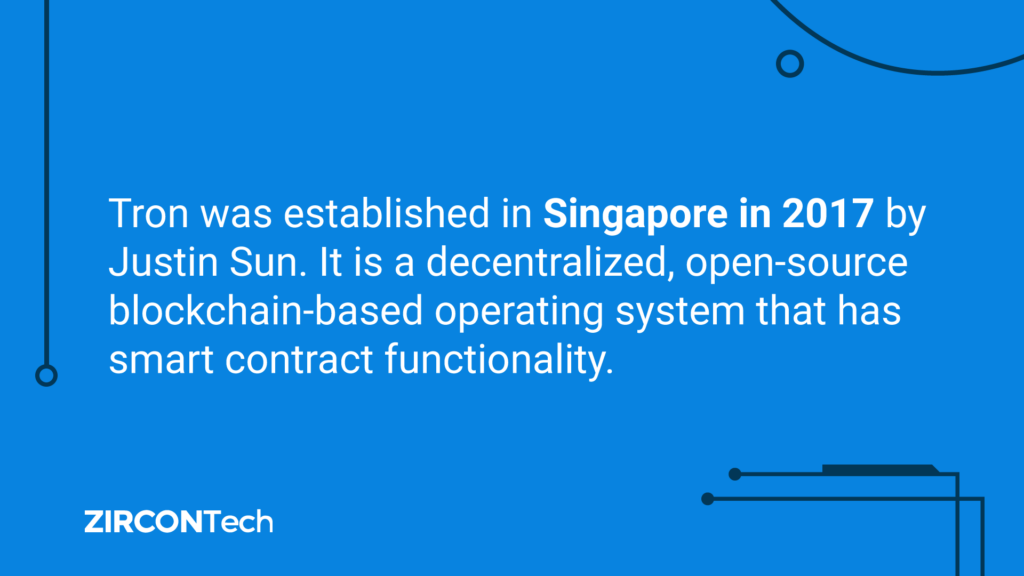Tron is a name that has been making headlines in recent weeks and months in the cryptocurrency space. Specifically, people have been made aware of the surge in the number of transactions it has recorded, and the prevalence of Tron smart contract activity within that record.
Increasing numbers of people and businesses want a smart contract on the Tron blockchain. Recent numbers show that there had been just under three billion transactions on Tron – and nearly 1.8 billion of those triggered a Tron smart contract.
Clearly, Tron is a cryptocurrency and a proof-of-stake operating system in demand. So what more do we need to know about Tron? And why is it that for so many people, when they want a smart contract Tron is the answer?
Let’s take a detailed look at the concept of smart contracts, at the history of Tron, and see why a Tron smart contract is so in demand right now.
Introduction to smart contracts – what are they and what do they do?

Smart contracts have been in existence since the early 1990s. Well-known computer scientist Nick Szabo came up with the label, describing a smart contract as “a set of promises, specified in digital form, including protocols within which the parties perform on these promises”.
It is possible to read that definition and see that – apart from the words “specified in digital form” – this could describe any form of contract, or legal agreement, relating to personal or business transactions at any time over the centuries.
However, in the early 1990s the digital revolution was in its early stages. Ever since, smart contracts have been seen as a purely online concept.
A smart contract has the terms of the agreement it relates to directly written into lines of code. This code, and thus the agreement in question, exists across a distributed and decentralized blockchain network. Part of the code controls the execution of the contract, and any transactions are trackable and cannot be reversed.

The transparency and traceability inherent in a smart contract help to explain the appeal of a Tron smart contract. And, because the processing of a smart contract is automated, all participants can be certain of the outcome in real time. There is no need for any delay or human intervention.
There are several real-world use cases that demonstrate the versatility of smart contracts, and the value they can bring to a host of commercial contexts and applications. They include:
- Finance: Decentralized finance provides a parallel service to the traditional banking and financial services industry. Borrowing, trading and lending can all be administered by smart contracts, whose increased transparency opens the door for people around the globe to enter the financial services arena.
- Gaming: This is now a hundred-billion-dollar global industry, and blockchain technology can enable players to capture the value of in-game purchases more effectively. That technology is driven by NFTs, which in turn rely on smart contracts to lock in their unique status. There are numerous examples of individuals using a Tron smart contract in a gaming context.
- Legal: Smart contracts can be used as legally binding agreements. Just as e-signatures have become commonplace in commercial transactions, smart contracts are used with ever-greater frequency – which can lower costs and increase the speed with which transactions are completed.
- Real estate: Everybody who has bought or sold a home knows what a complex procedure this can be. By tokenizing a piece of property and making it subject to a smart contract, much of the time and expense of the process can potentially be eradicated. Rental and mortgage agreements, as well as insurance deals, can similarly benefit from the application of a smart contract.
- Corporate: As long ago as 2017, Delaware passed a bill allowing businesses to be managed using blockchain technology. Decentralized autonomous organizations (DAO) now function using smart contracts, which saves on administrative costs, office space and payroll.
- Emerging technologies: If you combine the data processing capabilities inherent in artificial intelligence and machine learning with the decentralized security of blockchain technology, the potential exists to create AI-driven smart contracts. The fusion of AI and blockchain represents potentially a most exciting development.
Ultimately, the earliest illustration of the concept of a smart contract remains one of its most compelling. A smart contract is like a vending machine. When you buy from such a machine, you do not have to deal directly with the seller – you put your money in their machine and trust that the food or drink you have chosen will emerge in return. This type of direct transaction, without the need to know or trust the other party, is what makes smart contracts so appealing.
Introduction to Tron and its sharp growth in the first half of 2022

Tron was established in Singapore in 2017 by Justin Sun. It is a decentralized, open-source blockchain-based operating system that has smart contract functionality. It also has a cryptocurrency native to the system called Tronix (TRX).
Originally an Ethereum-based ERC-20 token, it switched its protocol to its own blockchain in 2018. By the start of the following year, it had a total market capitalization of $1.6billion.
In the first half of 2022, a time of great instability in the cryptocurrency market, Tron began to display some exceptional results. More and more people and businesses obviously wanted to create a smart contract on the Tron blockchain. It made eye-catching gains in terms of market capitalization, with a 16.22% weekly rise recorded in May 2022.
In a single week in that month, almost 1.5million new accounts were added, bringing the total number of accounts on the Tron mainnet to just over 93.5million. By this stage, the total value locked (TVL) on the blockchain had reached $9.2billion.
As previously mentioned, more than 60% of the total transactions on Tron now relates to Tron smart contract activity.
Tron users need to acquire resources to transact or interact with a smart contract on the Tron blockchain. These resources are split into four types: bandwidth, CPU, storage and RAM. Tron has its own virtual machine, the TVM, which is the operating system used for running smart contracts in a decentralized but secure and reliable environment.
What makes people create their smart contract on Tron?
The main overriding reason why Tron has become such a popular application is that it is regarded as being extremely flexible and adaptable. The extra levels of security it has added also gives confidence and reassurance to people who want to create a Tron smart contract.
The features that make Tron stand out for the crowd among people who want to access content with no geographical restrictions, censorship or limitation include:
- On-Chain Governance: Like many other blockchain platforms, Tron supports democratic on-chain governance. This allows TRX holders to actively shape the future of the platform. They select the super-representatives, and their partners, who make sure the will of the community is heard and respected. Anybody who takes part in the voting process receives a fraction of the network rewards.
- Token Support: Tron supports a range of token standards, which in turn helps developers to power a range of novel use cases.
- Scalability: Tron has been specifically designed to support on-chain scaling. It allows developers to build applications that can support tens of thousands of concurrent users. Tron’s delegated proof-of-stake system, so central to the process of creating a Tron contract, can handle more than 2,000 transactions per second – and the potential is there for more.
- Well-Developed Ecosystem: Tron is now at the center of a well-developed ecosystem of DeFi products and DApps. This includes the decentralized file-sharing protocol BitTorrent and the JUST ecosystem of DeFi platforms. Because Tron’s TVM is compatible with the Ethereum Virtual Machine, it is easy for developers to port their DApps from Ethereum to Tron.
Features and benefits of Tron smart contract
We have already mentioned the flexibility and adaptability that make Tron so popular with developers and others looking to sign a smart contract on the Tron blockchain. There are other reasons why Tron is seen as one of the leading blockchain solutions available, particularly when it comes to creating a Tron contract.
- Streamlined communication: Tron was designed specifically for this purpose, which ensures easy integration with a host of sophisticated programming languages. Tron is designed as a three-layer system, with a core layer, storage layer and application layer. A Tron smart contract will be administered by the core layer.
- Protobuf: This is a data serializing protocol that facilitates the speedy execution of a smart contract on the Tron blockchain. Protobuf enables quick and efficient communication between systems and platforms – and its encoding and decoding are faster than JSON or XML.
- The Tron Virtual Machine: Having an efficient virtual machine is critical in the creation and management of a Tron smart contract. Once a Tron contract is uploaded to the mainnet, it is executed on the TVM. As previously mentioned, Tron is currently capable of supporting 2,000 transactions per second, with a transaction speed of just 14 seconds. This functionality is underpinned by a lightweight architecture, which reduces the consumption of resources and empowers a higher performing system.
Many developers believe that Tron is the blockchain that is leading the drive to Web 3.0 because of its adaptability. Its flexibility in allowing the use of any high-level language to develop a Tron smart contract is seen as a seriously important benefit.
Step-by-step guide to deploying a Tron smart contract

So you have decided to create a smart contract on the Tron blockchain. How precisely do you go about it? Here is a simple guide to the steps you will need to take:
- Set up your Integrated Development Environment (IDE) – you will need Google Chrome and a TronLink wallet. This wallet can be obtained from the Google Chrome app store and configured for the correct network. You will also need some TRX, which should be available free of charge in your testnet.
- Create your Solidity Script – open a new sample file and give it a name.
- Compile – activate the Solidity Compiler from the plug-in manager. The Solidity Compiler will be added to the list of active modules.
- Resolve issues – go to the Solidity Compiler module and click on Compile.
- Deploy – return to the plug-in manager and activate the Deployment plug-in. Log into the Tronlink wallet Google Chrome app extension and select your testnet from the dropdown menu. Then click on Deploy in the Deployment plug-in – having made sure you have sufficient funds in your wallet.
The process is complete, and you have deployed a smart contract on the Tron blockchain.
Need more help? Contact an experienced blockchain partner in ZirconTech

By now it should be clear why so many individuals and organizations in cryptocurrency and elsewhere in the metaverse are using Tron when they require a smart contract.
The speed, flexibility and all-round excellence in smart contract delivery and management all go towards explaining why so many people choose to create a Tron smart contract.
Nevertheless, we appreciate that many people in organizations in the United States and elsewhere still require some expert assistance when it comes to navigating blockchain technologies.
ZirconTech has worked since 2017 with a host of North American system integrators as a technology partner in distributed ledger and blockchain technologies.
We have broad, deep experience in every aspect of digital transformation and work to create beneficial, long-term partnerships that ensure businesses remain at the cutting edge of technology.
If you would like to talk with us about how we can help you and your company, please get in touch today.
